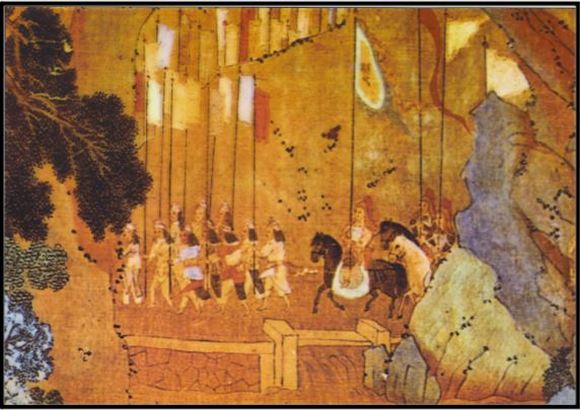China Han Dynasty Biography Activity
#2 Imperial Family

During the Han Dynasty the most powerful political figures were the emperor and members of the imperial family. The emperors, empresses, and their families both ruled and served the Chinese people. Like the Chinese emperors who preceded them, the Han emperors claimed to be “Sons of Heaven” with the authority to rule all the earth. This meant that the emperor was responsible only to Heaven and not subject to human authority. He expected obedience and loyalty from the people and, in turn, he was responsible for the people’s well-being.
The ruling emperor normally chose his own brother or one of his sons to succeed him. The son, called the “crown prince,” was often the emperor’s eldest son. However, sometimes the emperor chose his favorite son, his most intelligent son, or even a son by one of his wives who belonged to a wealthy and powerful family.
Once the emperor chose his successor, the mother of the crown prince automatically became empress. Her family then began to assume power and influence. Her father and brothers were often granted large estates of land, called fiefs. Many of her other close relatives managed to obtain government positions. Soon, the imperial family - which consisted of relatives of both the emperor and the empress - grew quite large.
The imperial family ruled the empire from a palace in the capital city. The emperor lived in the inner-most part of the palace, protected from criminals and bandits, and hidden from the watchful eyes of common onlookers. Various servants, advisers, and other court officials saw to his every need.
The emperor had many responsibilities. He led religious and official ceremonies. The most important ceremonies were those in which he asked Heaven and Earth for a good harvest. On the longest night of the year, he dressed in a blue robe and went without eating, or fasted, all night long. Before dawn the next morning, he prayed at a special outdoor altar. On the first day of spring, the emperor plowed part of a field on the palace grounds. Finally, on the longest day of the year, he dressed in a yellow robe and offered thanksgiving sacrifices for the harvest his people had received.
The emperor and the imperial families enjoyed a royal lifestyle. The main palace in the capital contained many grand halls and apartments for use by the emperor, his family, and other court favorites. Gardens and courtyards enclosed this area, and the entire palace was enclosed by a beautiful park with lakes, rare birds, and exotic animals. Inhabitants of the palace were often treated to lavish feasts that were served on fine porcelain plates, with drink poured in gold or silver goblets. There were also all-night parties where poets, musicians, singers, dancers, and jugglers often performed for the imperial families.
The ruling emperor normally chose his own brother or one of his sons to succeed him. The son, called the “crown prince,” was often the emperor’s eldest son. However, sometimes the emperor chose his favorite son, his most intelligent son, or even a son by one of his wives who belonged to a wealthy and powerful family.
Once the emperor chose his successor, the mother of the crown prince automatically became empress. Her family then began to assume power and influence. Her father and brothers were often granted large estates of land, called fiefs. Many of her other close relatives managed to obtain government positions. Soon, the imperial family - which consisted of relatives of both the emperor and the empress - grew quite large.
The imperial family ruled the empire from a palace in the capital city. The emperor lived in the inner-most part of the palace, protected from criminals and bandits, and hidden from the watchful eyes of common onlookers. Various servants, advisers, and other court officials saw to his every need.
The emperor had many responsibilities. He led religious and official ceremonies. The most important ceremonies were those in which he asked Heaven and Earth for a good harvest. On the longest night of the year, he dressed in a blue robe and went without eating, or fasted, all night long. Before dawn the next morning, he prayed at a special outdoor altar. On the first day of spring, the emperor plowed part of a field on the palace grounds. Finally, on the longest day of the year, he dressed in a yellow robe and offered thanksgiving sacrifices for the harvest his people had received.
The emperor and the imperial families enjoyed a royal lifestyle. The main palace in the capital contained many grand halls and apartments for use by the emperor, his family, and other court favorites. Gardens and courtyards enclosed this area, and the entire palace was enclosed by a beautiful park with lakes, rare birds, and exotic animals. Inhabitants of the palace were often treated to lavish feasts that were served on fine porcelain plates, with drink poured in gold or silver goblets. There were also all-night parties where poets, musicians, singers, dancers, and jugglers often performed for the imperial families.
